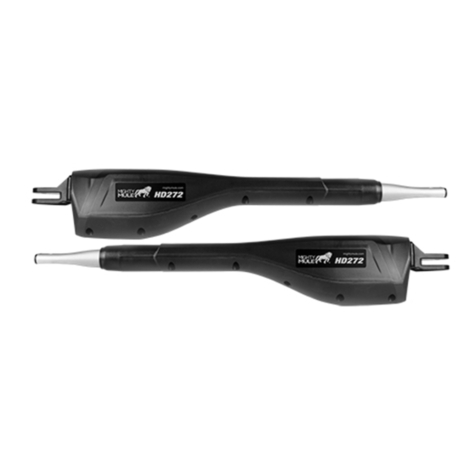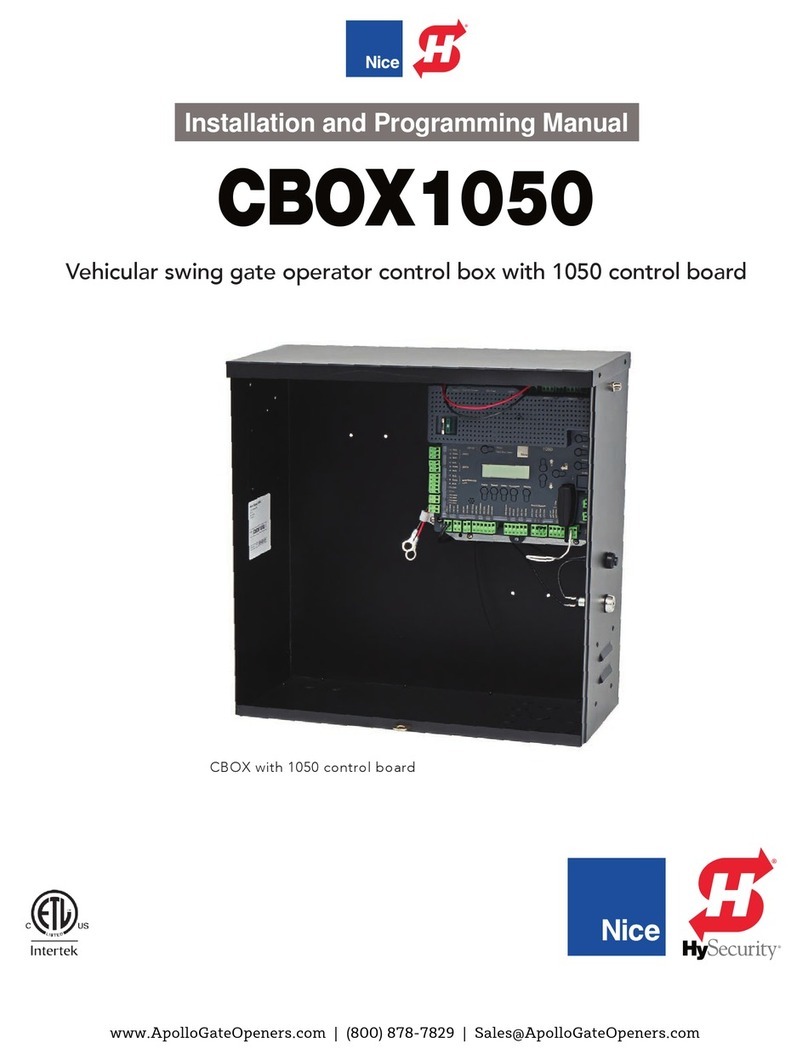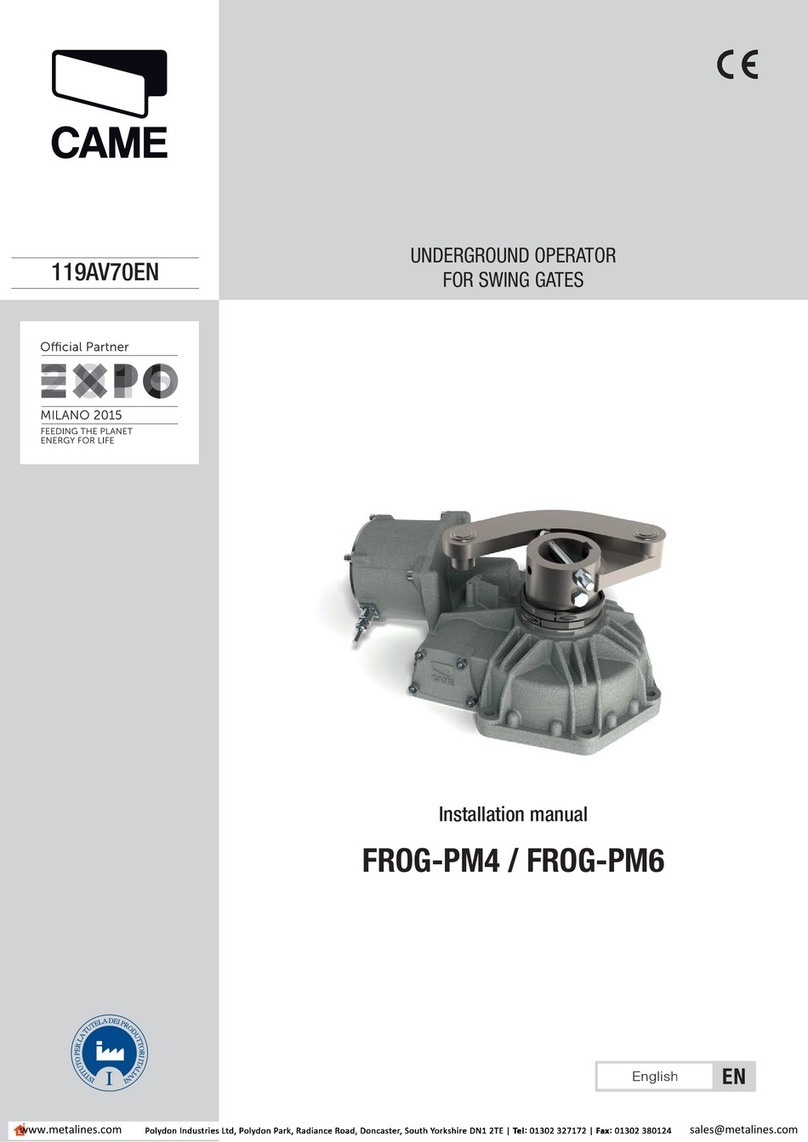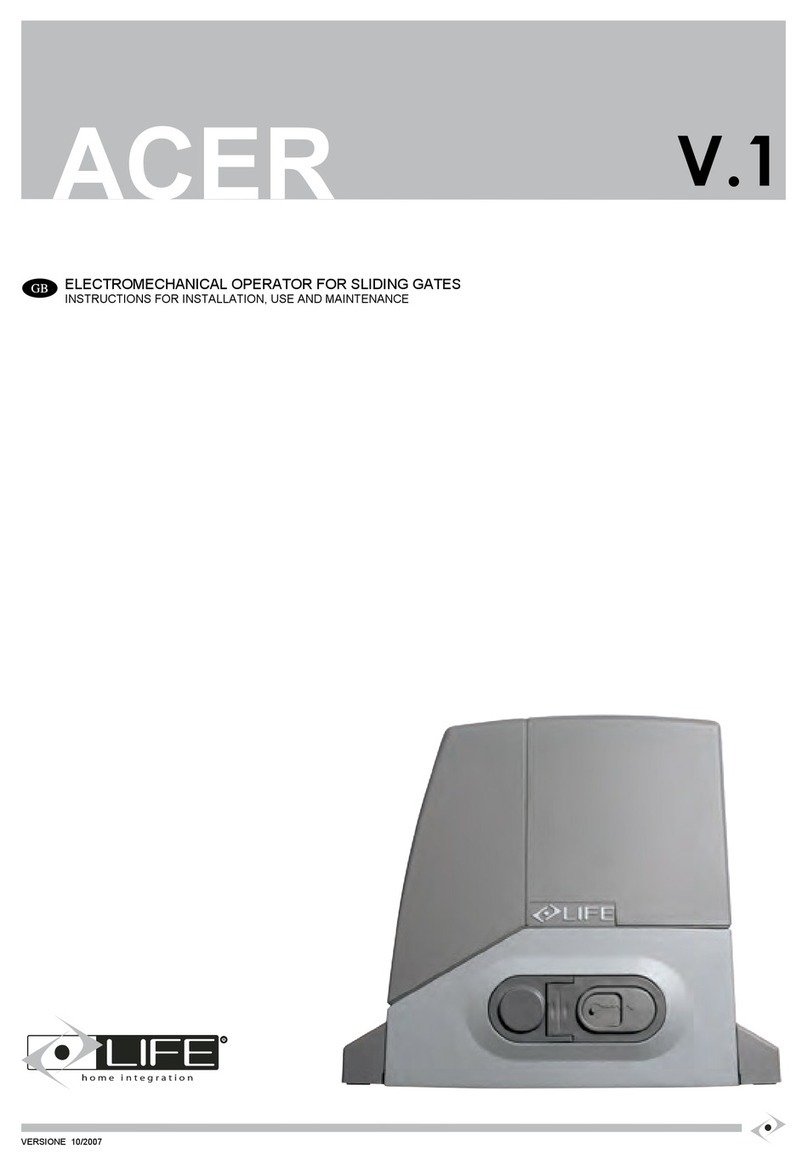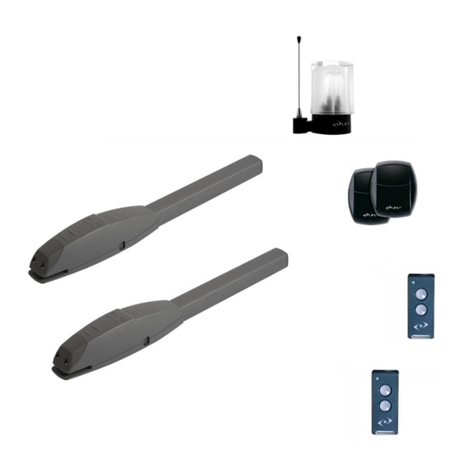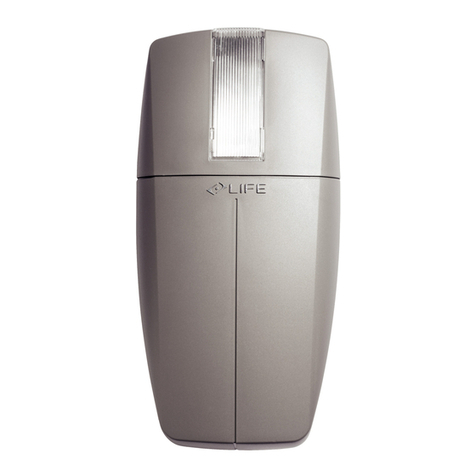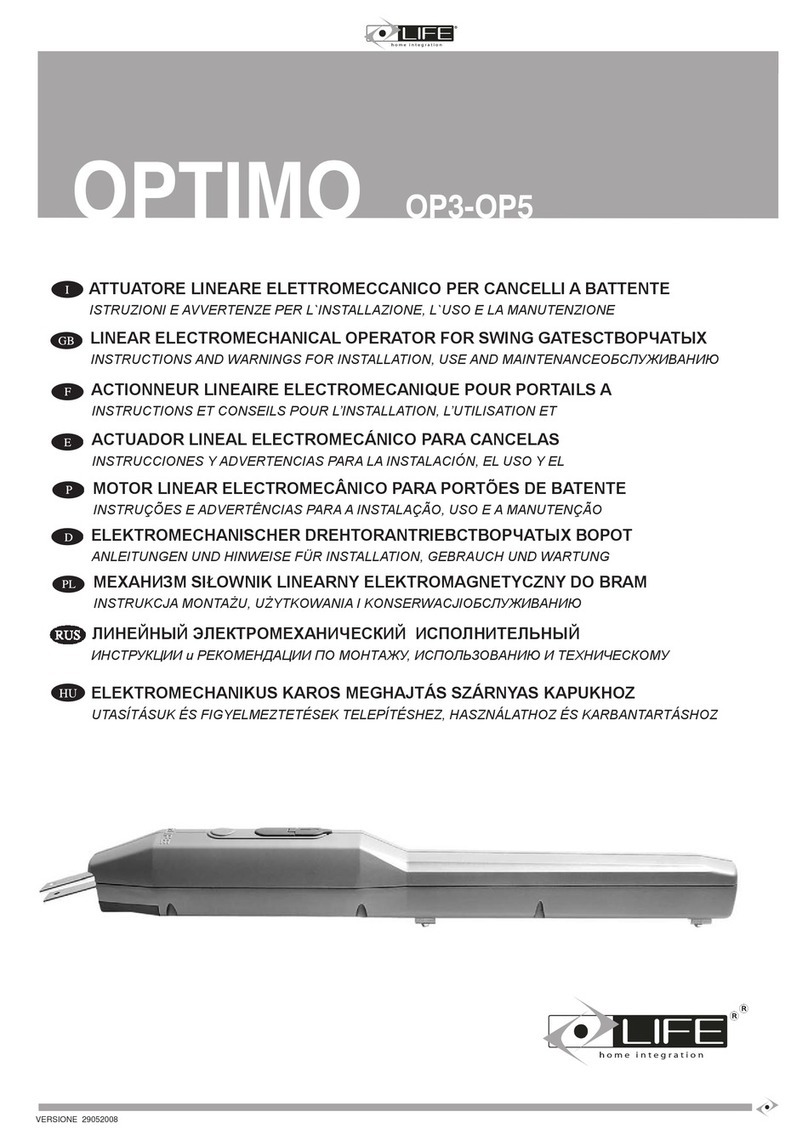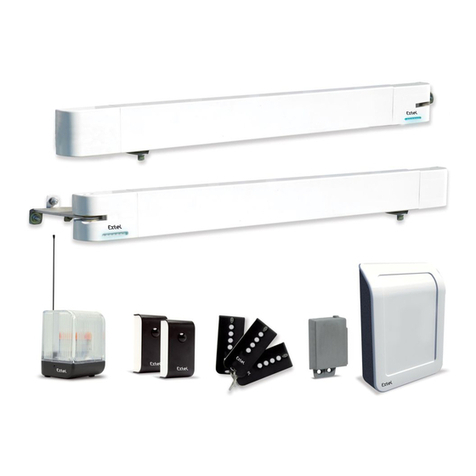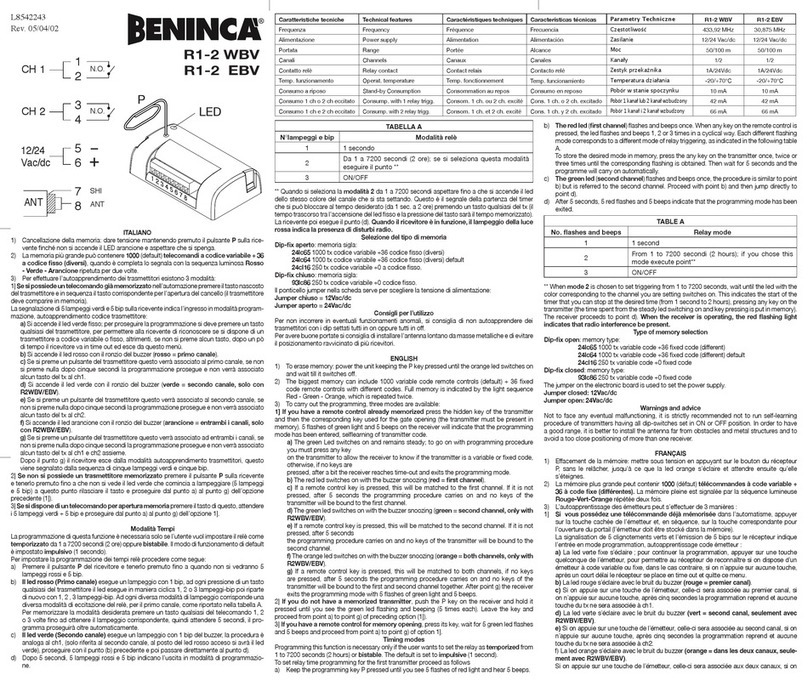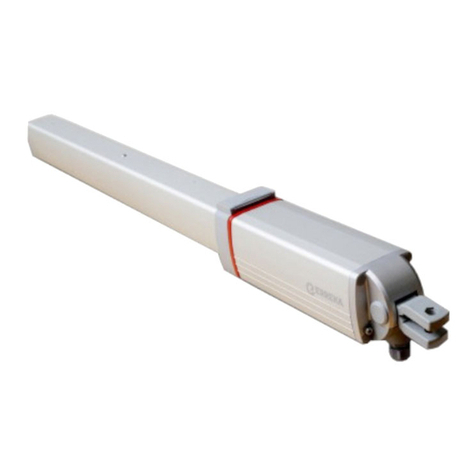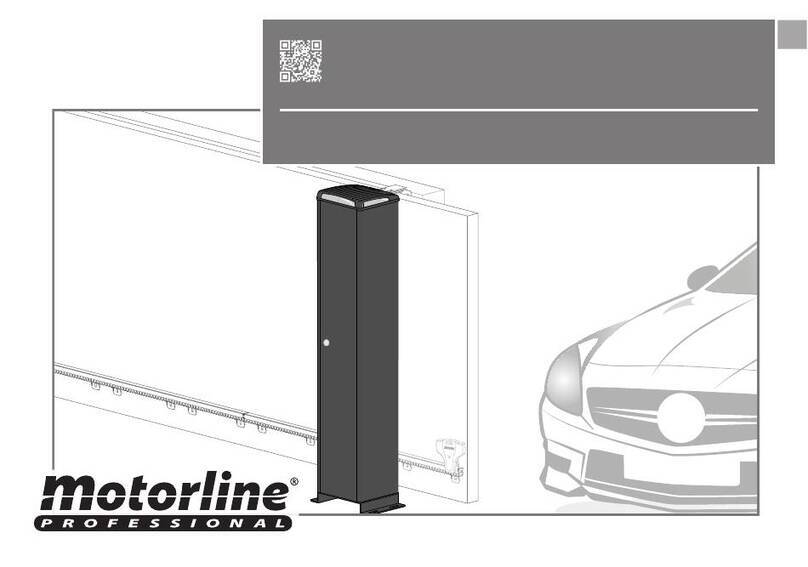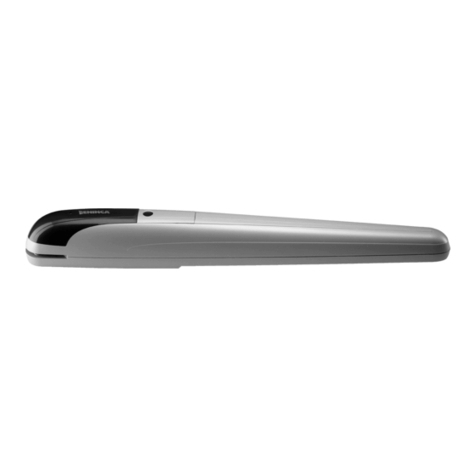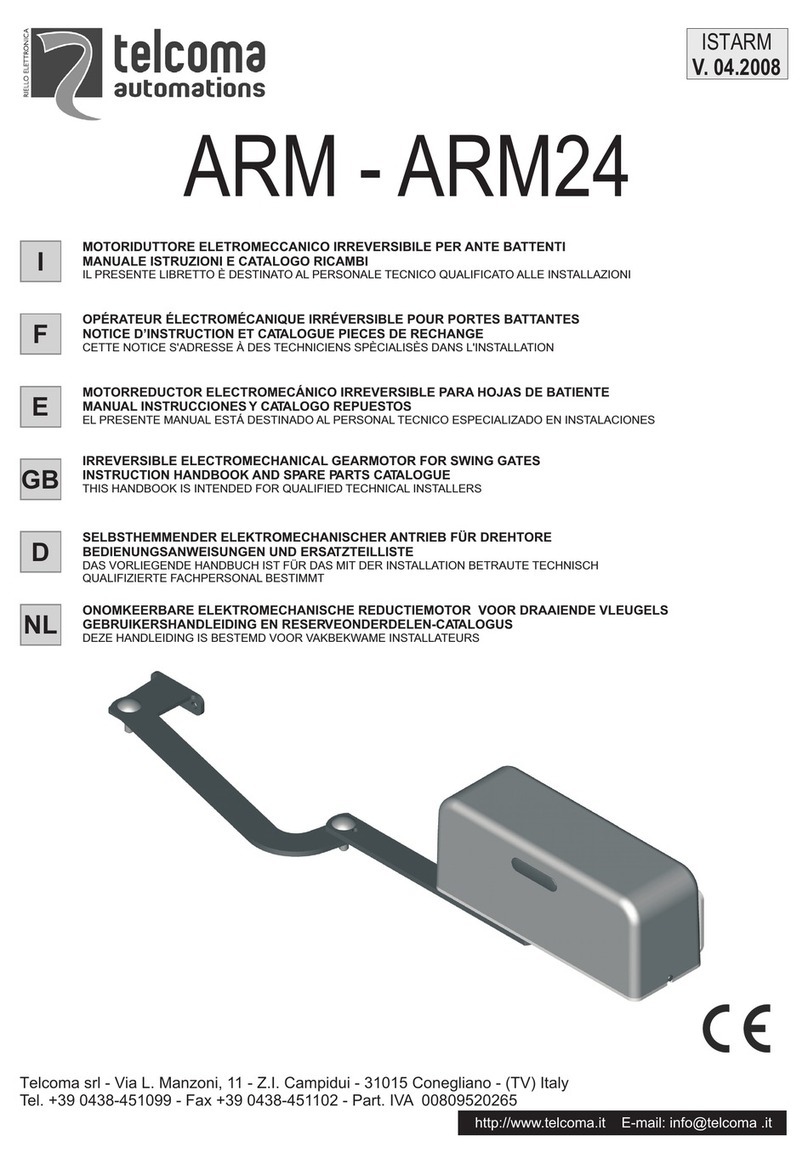GBI F
• Durante l’installazione tenere protetti i
componenti dell’automazione per evitare
che vi possano penetrare all’interno liquidi
(es. pioggia) e/o corpi estranei (terra,
ghiaino, ecc.).
• Il materiale dell’imballaggio deve essere
smaltito nel pieno rispetto della normativa
locale.
• Indossare occhiali di protezione quando
si devono praticare i fori di fissaggio.
• Nel caso di lavori in quota (sopra i 2 m da
terra), ad esempio per installare il
segnalatore luminoso o l’antenna, è
necessario che il personale compente sia
attrezzato di scale, imbragature di
sicurezza, casco di protezione ed
quant’altro previsto dalle leggi e dalle
norme per l’esecuzione di tali lavori. Fare
riferimento alla direttiva 89/655/CEE
modificata dalla 2001/45/CE.
4.2 VERIFICHE PRELIMINARI
Prima di procedere all’inst allazione è
necessario effettuare le seguenti verifiche
preliminari:
1) Le ante del cancello devono avere peso
e dimensioni che rientrano nei limiti di
impiego (vedere cap. DATI TECNICI e
LIMITI D’IMPIEGO), in caso contrario
l’attuatore lineare elettromeccanico
ARMOR non può essere installato.
2) La struttura delle ante deve essere
adatta al montaggio dell’attuatore e
conforme alle norme vigenti.
Eventualmente prevedere dispositivi
ulteriori per garantire la sicurezza di
funzionamento.
3) Le ante del cancello devono essere
solide e robuste; le cerniere devono
essere adeguate alle dimensioni e al
peso delle ante, avere giochi minimi ed
essere solidamente fissate.
4) Il movimento delle ante, sia in chiusura
che in apertura, deve essere uniforme:
non vi devono essere punti in cui la
resistenza alla rotazione o l’attrito sia
maggiore. Eseguire manualmente
alcuni movimenti di prova aprendo e
chiudendo più volte più volte le ante.
5) Le ante del cancello devono essere ben
bilanciate, cioè non devono muoversi se
lasciate ferme in qualsiasi posizione
durante l’apertura o la chiusura.
Controllare inoltre che le ante non
sbandino o flettano durante il
movimento.
6) Le cerniere delle ante del cancello
devono essere perfettamente verticali,
onde evitare sbandamenti durante il
funzionamento.
7) Nei cancelli a due ante, nel punto di
chiusura le ante devono incontrarsi e
combaciare perfettamente per tutta
l’altezza, senza sforzare una contro
l’altra o rimanere troppo lontane; devono
inoltre essere perfettamente verticali.
• Pendant l’installation, protéger les
composantes du système automatisé afin
d’éviter l’éventuelle pénétration de
liquides (par ex. pluie) et / ou de corps
étrangers (terre, gravier, etc.).
• Détruire le matériel d’emballage dans le
respect des normes locales.
• Porter des lunettes de protection au
moment d’effectuer les trous de fixation.
• En cas de travaux en hauteur (au-delà
de 2 mètres), pour installer par exemple
le clignotant ou l’antenne, les techniciens
professionnels doivent utiliser des
échelles, des harnais de sécurité, porter
un casque de protection et tout ce qui est
prévu par la loi et les normes relatives à
la réalisation de tels travaux. Se référer à
la directive 89/655/CEE modifiée par la
directive 2001/45/CE.
4.2 V É R I F I C A T I O N S
PRÉLIMINAIRES
Avant l’installation, il est nécessaire
d’effectuer les contrôles préliminaires
suivants:
1) Les vantaux du portail doivent présenter
un poids et des dimensions qui sont
conformes à l’emploi prévu (voir chap.
DONNEES TECHNIQUES ET LIMITES
D’UTILISATION), sans quoi il n’est pas
possible d’installer l’actionneur
électromécanique ARMOR.
2) Il faut que la structure des vantaux soit
adaptée à l’installation de l’actionneur
conformément aux normes en vigueur.
Prévoir éventuellement d’autres
dispositifs afin d’en assurer le
fonctionnement.
3) Les vantaux du portail doivent être
solides et robustes; les charnières
doivent être adaptées aux dimensions
et au poids des vantaux, avoir
suffisamment de jeu et être solidement
fixés.
4) Le mouvement des vantaux doit être
uniforme, au moment de la fermeture
et de l’ouverture: il ne faut pas qu’il y ait
des points de résistance ou de
frottement. Effectuer manuellement
quelques mouvements d’ouverture et de
fermeture des vantaux à titre d’essai.
5) Les vantaux du portail doivent être bien
équilibrés, c’est-à-dire qu’ils ne doivent
pas bouger s’ils sont fixes dans
n’importe quelle position pendant
l’ouverture ou la fermeture. Vérifier
également que les vantaux ne dévient
pas ni ne s’inclinent pendant le
mouvement.
6) Les charnières des vantaux du portail
doivent être parfaitement verticales pour
éviter des déviations pendant le
fonctionnement.
7) Dans les portails à deux vantaux, au
niveau de la fermeture, les vantaux
doivent se rencontrer et concorder
parfaitement sur toute la hauteur, sans
les forcer ni les tenir trop éloignés et
doivent être parfaitement verticaux.
• Ensure that the place of installation is not
prone to flooding, does not contain
sources of heat or naked flames, fires or
hazard situations in general.
• During installation, protect automation
components to prevent liquids (e.g. rain)
and/or foreign bodies (earth, gravel, etc)
penetrating inside.
• Wrapping materials must be disposed of
in compliance with local regulations.
• Wear protective goggles when making
holes for clamping.
• In the event of works at heights of over
2m from the ground, for example for the
installation of the indicator lamp or aerial,
fitters must be equipped with ladders,
safety harnesses, protective helmet, and
all other equipment required by law and
the standards governing this kind of work.
Refer to Directive 89/655/EEC amended
by 2001/45/EC.
4.2 PRELIMINARY CHECKS
Before commencing installation, the following
checks must be performed:
1) The weight and dimensions of the gate
must not exceed the limits for use (see
the TECHNICAL DATA and USAGE
RESTRICTIONS chaps.), if they exceed
such limits, the ARMOR operator may
not be installed.
2) The structure of the gate leaf must be
suitable for the installation of the
operator and conform to current
standards. Provide all devices
necessary to guarantee safe operation.
3) The gate leaves must be sturdy and
solid; the hinges must be suited to the
dimensions and weight of the leaves,
gaps between parts must be minimal
and they must be solidly fixed.
4) The gate’s movement in both opening
and closure must be uniform, without
points of greater resistance to rotation
or friction. Check manually by opening
and closing the leaves several times.
5) The gate leaves must be well balanced,
i.e. they must not move when left in any
point during opening or closure. Ensure
that the leaves not bend or deviate from
their course during movement.
6) Gate leaf hinges must be perfectly
vertical in order to avoid deviations
during operation,
7) In two-leaf gates, when completely
closed the two leaves must meet and
match perfectly for their entire height,
without forcing one against the other or
remaining too distant, and they must be
perfectly vertical.
